Sacred Splendor: The Top 12 Must-Visit Churches in Rome
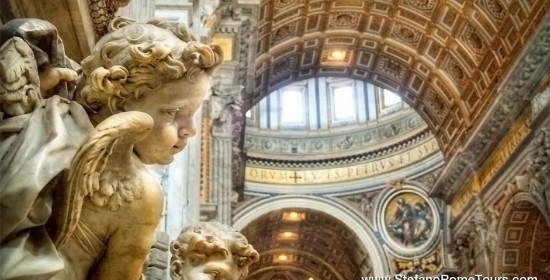
Buongiorno and welcome to Stefano Rome Tours, Rome’s leading tour company for private tours of Rome, and Civitavecchia Shore Excursions. Rome, known as the Eternal City, is a treasure trove of rich history, art, and divine architecture, with its churches standing as timeless witnesses to centuries of faith and culture. In this travel blog, we take you on a spiritual and architectural journey through the heart of Rome to the top 12 must-visit churches in Rome.
From ancient basilicas adorned with mesmerizing mosaics to Renaissance wonders housing masterpieces by the likes of Michelangelo and Bernini, Rome's churches stand as living chronicles of the city's rich cultural and religious past.
Discover some of Rome's most iconic churches, each boasting unique stories, breathtaking designs, and a profound connection to the city's religious and cultural heritage. Join us as we explore the sacred splendor of Rome's most revered churches.
Top 12 Must-Visit Churches in Rome
1. Saint Peter's Basilica
Saint Peter's Basilica stands as a symbol of the grandeur and spiritual significance of the Catholic Church. Its construction began in 1506 under the direction of Pope Julius II to replace the previous Old Saint Peter Basilica commissioned by Emperor Constantine in the 4th century. The new basilica was completed in 1626, combining the efforts of various renowned architects and artists, including Bramante, Michelangelo, and Gian Lorenzo Bernini. The basilica is situated in Vatican City, the smallest independent state in the world, surrounded by Rome.
The historical and religious significance of Saint Peter's Basilica is deeply rooted in its association with Saint Peter, considered the first pope and one of the twelve apostles chosen by Jesus. According to tradition, St. Peter was martyred in Rome, and his tomb is believed to be directly beneath the main altar of the Basilica. Pilgrims from around the world visit the basilica to pay homage to Saint Peter and seek spiritual solace.
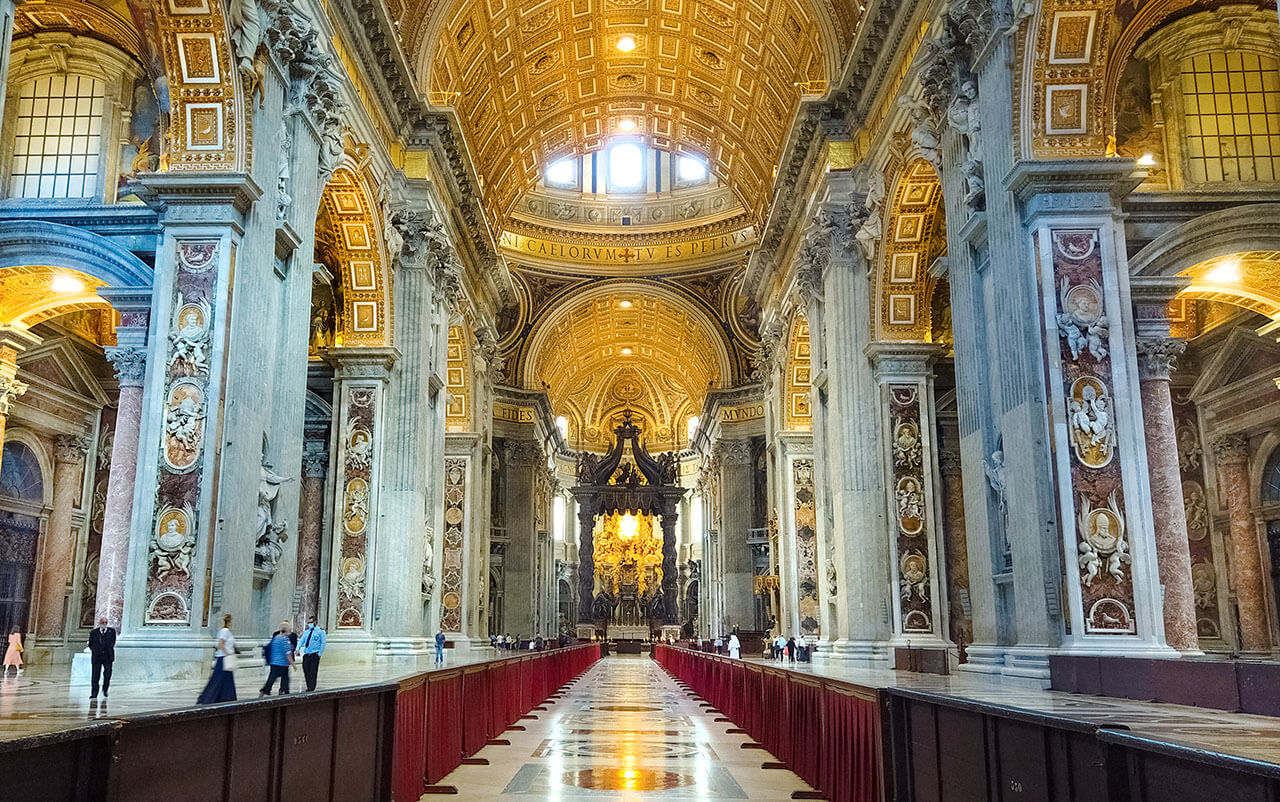
Must-See Works of Art and Architecture of Saint Peter’s Basilica:
Bernini's Canopy (Baldacchino)
Gianlorenzo Bernini's monumental bronze canopy, commissioned by Pope Urban VIII in 1624, stands over 28 meters high at the end of Saint Peter's Basilica, emphasizing the main altar exclusively for the Pope. Its spiral columns, adorned with vine leaves, create an illusion of movement and lightness. The structure's bronze allegedly came from ancient buildings, adding intrigue to its history. This narrative birthed the famous saying, "What the barbarians didn’t take, the Barberini did", though recent studies have not confirmed this historical tale. Angels and putti grace the top, culminating in a golden sphere with a cross.
Statue of Saint Peter:
Attributed to Arnolfo di Cambio, the bronze statue of Saint Peter, seated on a marble chair, dates back to the late 1200s. Pilgrim's tradition of touching or kissing Saint Peter's feet, particularly the right one, seeks his blessing. The worn-out foot tells a story of centuries of devotion.
Pieta by Michelangelo:
Michelangelo's "Pieta" is a marble sculpture located in the first chapel to the right upon entering the basilica. Created when Michelangelo was only 24 years old, it is a poignant representation of the Virgin Mary cradling the lifeless body of Jesus after his crucifixion.
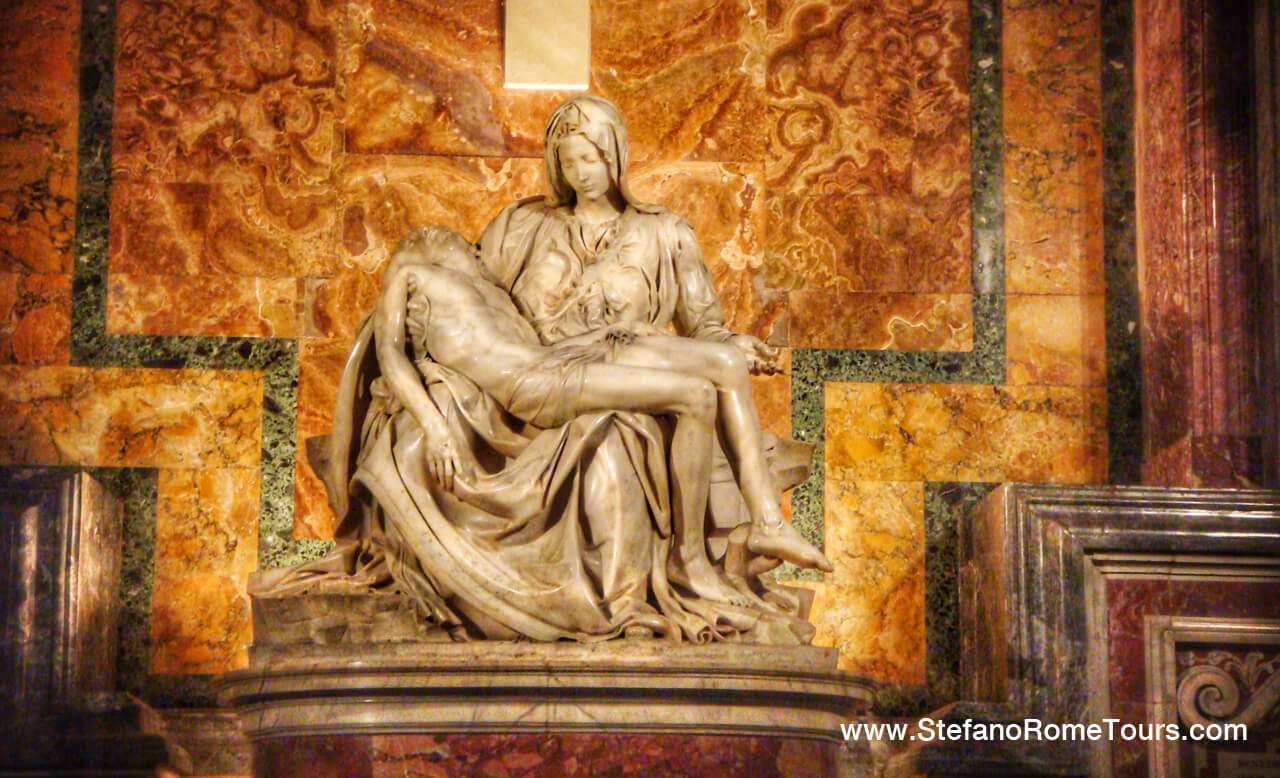
Dome by Michelangelo:
St. Peter's Dome, or the "Cupola", is an architectural marvel designed by Michelangelo. The dome was completed after Michelangelo's death but follows his original design. Rising 136 meters (446 feet) above the basilica, the dome is a dominant feature of the Rome skyline. It is adorned with intricate mosaics depicting scenes from the life of Christ and is crowned by a lantern symbolizing the divine light.
Visitors can ascend to the top of the dome for breathtaking panoramic views of Rome, providing a unique perspective on the city's landmarks.
The combination of religious significance, architectural grandeur, and iconic works of art make St. Peter's Basilica a must-visit destination for both pilgrims and admirers of art and history, showcasing the enduring legacy of the Catholic Church and the Renaissance period.
2. Basilica of Saint Paul Outside the Walls
Built along the Ostiense Way, the Papal Basilica of Saint Paul Outside the Walls stands as a majestic testament to the enduring legacy of Saint Paul of Tarsus. Founded by Emperor Constantine I over the burial site of the apostle in 324, the basilica underwent subsequent expansions, with Emperor Theodosius I overseeing the construction of a grander structure in 386. The 5th-century basilica surpassed even the Old Saint Peter's Basilica in size, attracting praise from the Christian poet Prudentius during the reign of Emperor Honorius.
Despite facing challenges, including fire damage and the ravages of time, the basilica persevered. Leo I's repairs in the 5th century and Pope Benedict XIV's restoration efforts in the 18th century attest to its resilience. However, tragedy struck in 1823 when a fire nearly obliterated the basilica. Although reconstruction efforts, led by architects Pasquale Belli and Luigi Poletti, aimed to restore its fourth-century splendor, the result is a harmonious blend of historical remnants and 19th-century reinterpretation.
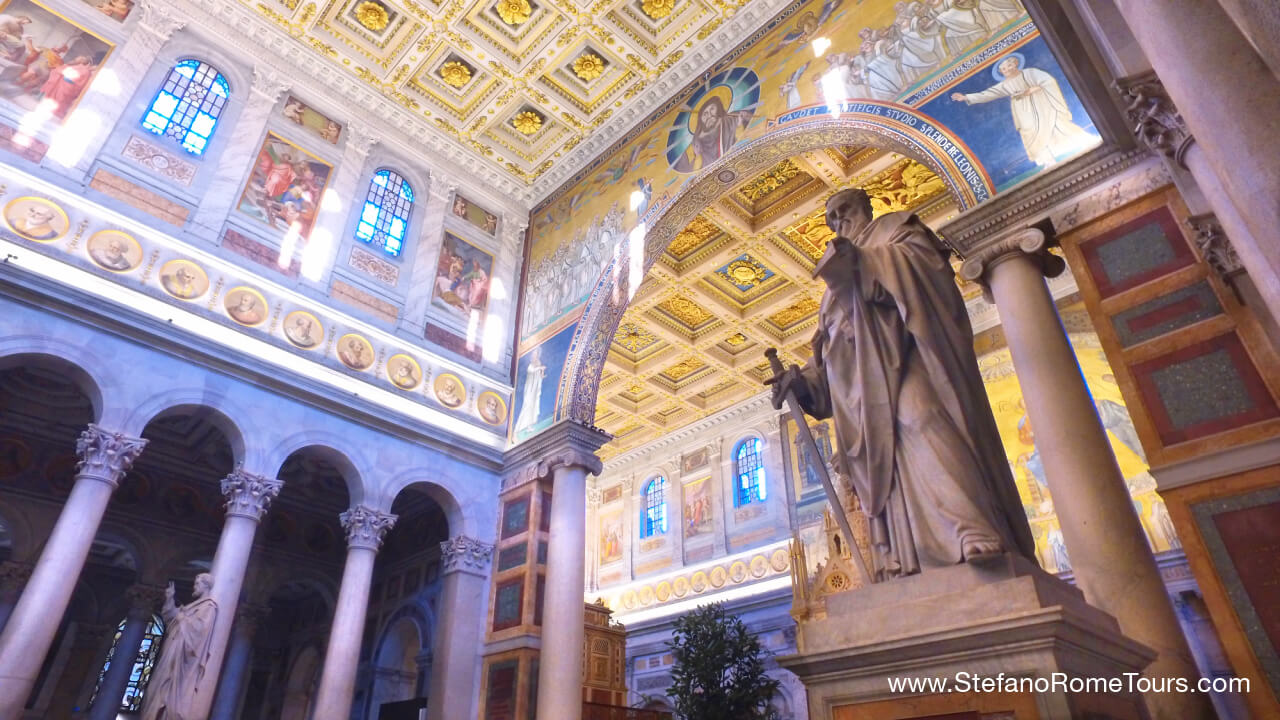
The Jubilee Door
The basilica's architecture, marked by a Neo-classicist portico, the Holy Door opened during Jubilees, and the Byzantine door adorned with bronze panels reflects centuries of evolution. The interior, with one nave and four side aisles, boasts 80 columns and a reconstructed ceiling from the 19th century. Fragments of the original 5th-century mosaics and the ciborium of the confession, crafted by Arnolfo di Cambio in the 13th century, contribute to the basilica's timeless allure.
The Cloister of St Paul Outside the Walls
The cloister, a masterpiece of medieval beauty built between 1220 and 1241, enhances the visitor's experience. Adorned with double columns featuring inlays of golden and colored-glass mosaics, it stands as a symbol of the basilica's enduring grace.
Burial Site of Saint Paul
The basilica's significance extends beyond its architectural grandeur. As the burial site of Saint Paul, tradition holds that his body rests beneath the altar, marked by a marble tombstone with a poignant Latin inscription. Recent archaeological endeavors, including the discovery of a white marble sarcophagus beneath the altar, add layers of authenticity to the basilica's storied history. Radiocarbon dating has further validated the presence of ancient bones, potentially those of Saint Paul, underscoring the basilica's spiritual and archaeological importance.
- Visit Saint Paul Outside the Walls on any of our exclusive private Tours of Rome and Shore Excursions from Civitavecchia: Postcard Rome Tour, Postcard Rome For Cruisers Shore Excursion from Civitavecchia, and our Postcard Rome Post Cruise Tour from Civitavecchia.
3. Church of Sant'Ignazio di Loyola
The Church of Sant'Ignazio di Loyola, situated in Campus Martius, Rome, is dedicated to St. Ignatius of Loyola, the founder of the Jesuit order. Constructed in the Baroque style between 1626 and 1650, the church originally served as the chapel for the adjacent Roman College later renamed the Pontifical Gregorian University.
The Church of St. Ignatius of Loyola was completed at the end of the 17th century, opening for public worship in 1650. The church's Latin cross plan, inspired by the Church of the Gesù, features Corinthian pilasters, vibrant marble, stucco reliefs, ornate altars, and trompe-l'œil paintings. Due to budget constraints, a dome wasn't built; instead, a painter, Andrea Pozzo, created an illusionary dome.
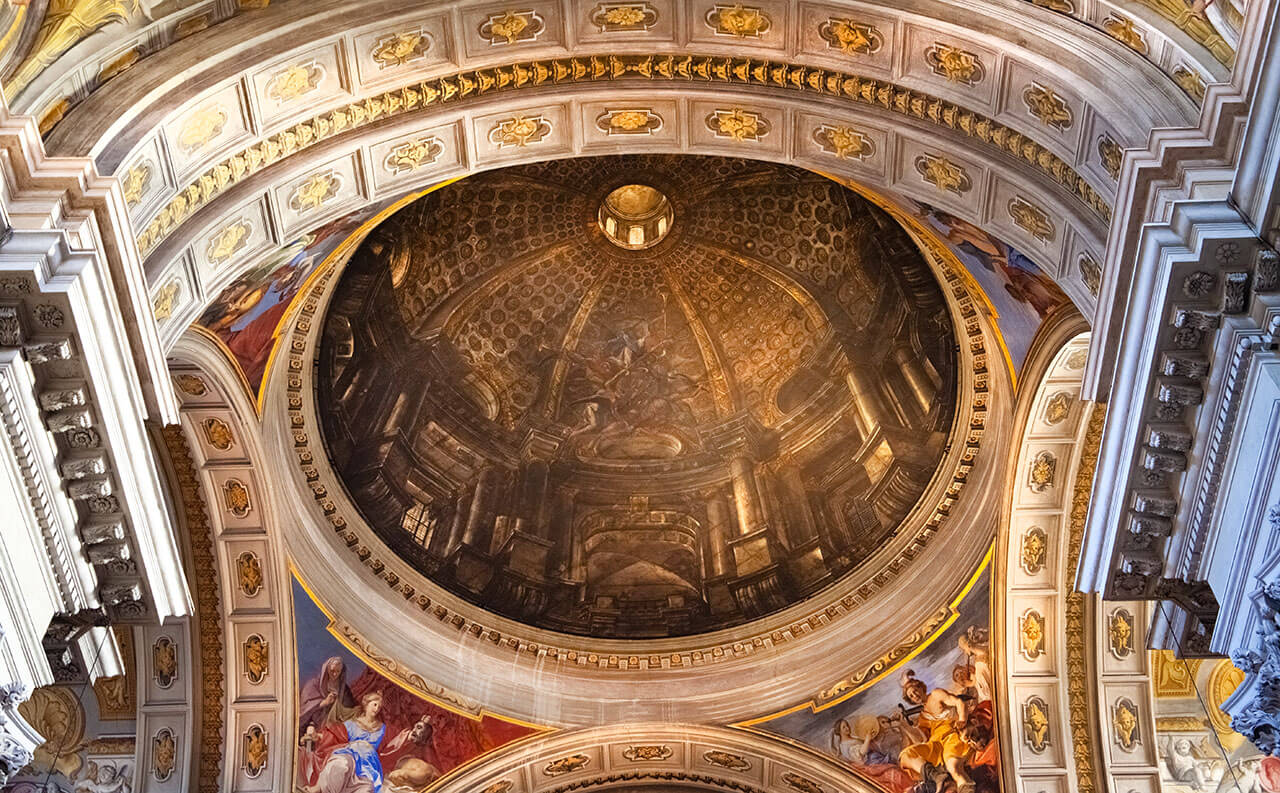
Look Up inside the Church of Sant'Ignazio di Loyola
Illusionary Dome at Sant'Ignazio
Upon entering the Church of Sant'Ignazio di Loyola, visitors may be entranced by an apparent dome in the nave. As they progress toward the altar, the dome, adorned with supporting elements, appears convincingly three-dimensional. However, a closer look near the altar unveils the deception—the dome is a masterfully painted illusion on the flat ceiling.
Crafted by Andrea Pozzo, this trompe-l'œil effect cleverly employs a strategic vanishing point, creating a tangible dome as one moves down the nave. The illusion persists until scrutiny reveals the truth near the altar.
Pozzo's artistic prowess extends beyond the dome to the vault, where he makes the entire basilica ceiling seemingly disappear. By ingeniously extending real architectural elements into the painted space, he doubles the perceived height of the basilica.
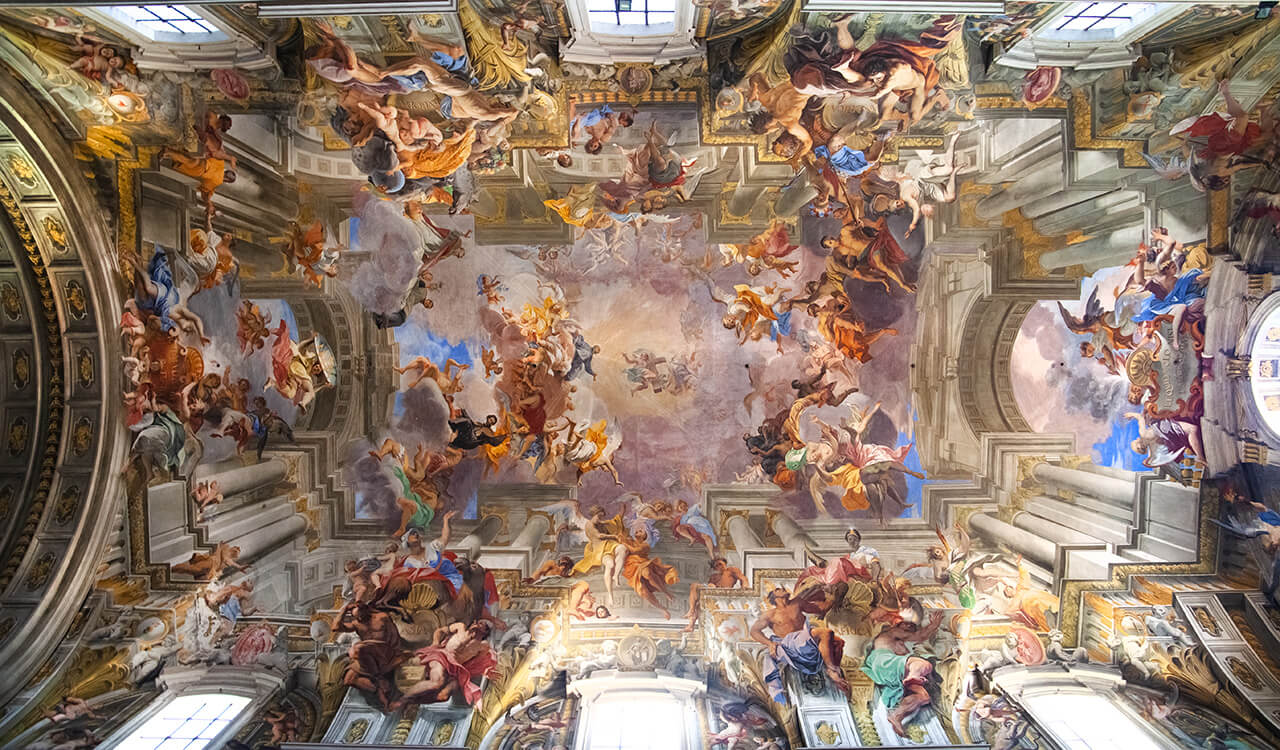
Notable artworks include a sculptural group by Alessandro Algardi, a stucco statue of St. Ignatius by Camillo Rusconi, and frescoes by Andrea Pozzo. Pozzo's ceiling fresco, painted around 1685, depicts St. Ignatius welcomed into paradise surrounded by allegorical representations of continents. Through skillful use of perspective, light, and shade, Pozzo created the illusion of a cupola on the nave's barrel vault.
The frescoes in the eastern apse by Pozzo depict the life and apotheosis of St. Ignatius, including the Siege of Pamplona, Vision of St. Ignatius at the Chapel of La Storta, and St. Ignatius Receiving Francesco Borgia.
Overall, the Church of Sant'Ignazio di Loyola stands as a remarkable example of Baroque architecture and houses significant artworks celebrating the legacy of St. Ignatius and the Jesuit order.
4. Basilica of Santa Maria del Popolo
Santa Maria del Popolo, situated next to Piazza del Popolo holds historical significance dating back to the medieval and Renaissance periods. Legend has it that Pope Paschal II, troubled by demonic activity, performed an exorcism at the site where Emperor Nero was buried. This event led to the construction of the chapel, marking the triumph of good over evil.
While its early history is somewhat obscured, the church gained prominence with the transfer of the Madonna del Popolo icon, attributed to Saint Luke. Following a flood and plague in 1230, this relocation became a pivotal moment in the church's history, attracting pilgrims and solidifying its role in the city.

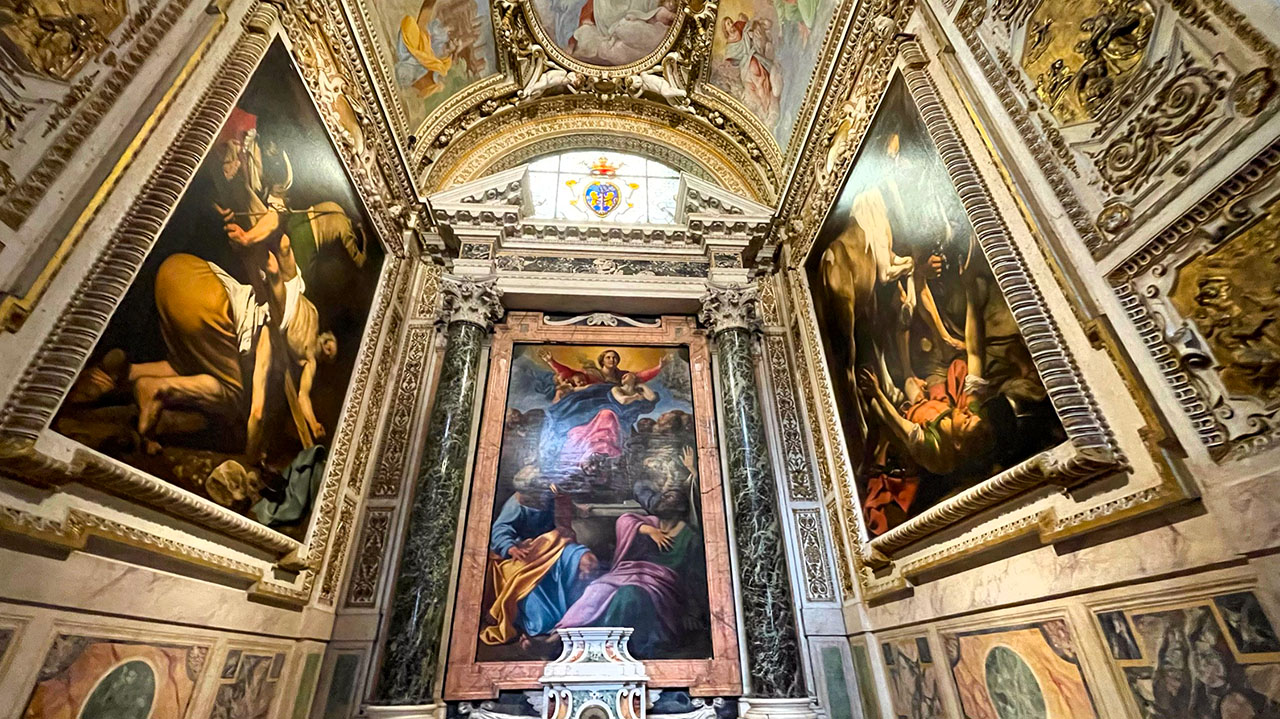
Famous Works of Art inside Santa Maria del Popolo
Caravaggio and the Cerasi Chapel:
In 1600, Monsignor Tiberio Cerasi initiated significant renovations, commissioning Carlo Maderno to design the chapel. Caravaggio's masterpieces, "Conversion of Saint Paul" and "Crucifixion of Saint Peter", adorn the Cerasi Chapel, contributing to the basilica's artistic prominence. Annibale Carracci's "Assumption of the Virgin" also enriches the chapel's artistic ensemble.
* Chigi Reconstruction and Bernini's Influence:
The Chigi Chapel is a testament to Raphael's architectural brilliance and a notable example of Italian Renaissance and Baroque art. Originally dedicated to Saints Sebastian, Roch, and Sigismund, it was later dedicated to the Madonna of Loreto in 1507 by Agostino Chigi, a wealthy banker. Raphael's reconstruction and the chapel's completion in 1516 marked a fusion of Christianity and classical antiquity, centered around the theme of the Resurrection.
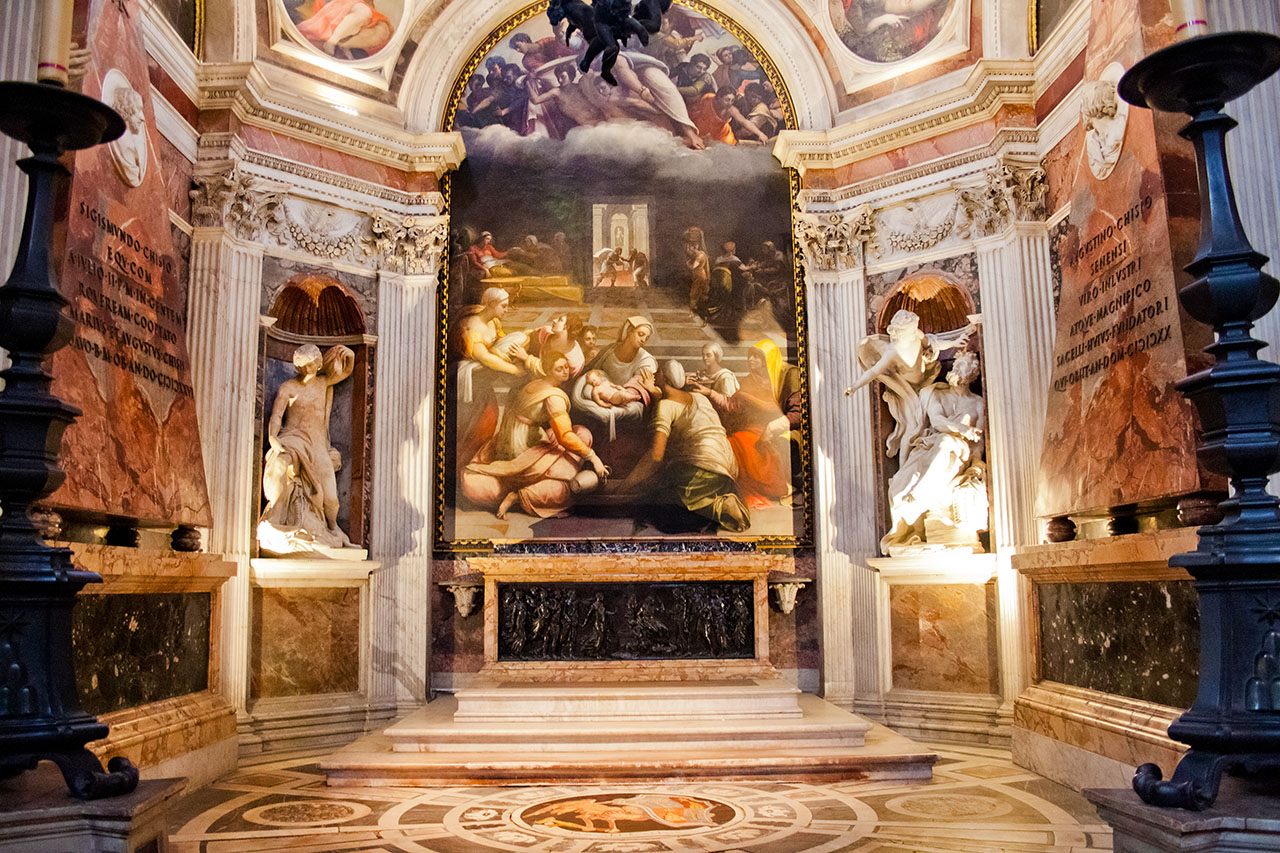
Despite interruptions and delays caused by the deaths of Agostino Chigi and Raphael, the chapel was unveiled in 1554 with frescoes by Francesco Salviati. In the 17th century, Gian Lorenzo Bernini further enhanced the structure, completing pyramids and introducing statues. The exterior exhibits simplicity with exposed brick, while the interior features a dome inspired by the Pantheon and elements from Bramante's designs.
The chapel's artistic highlights include mosaics by Luigi da Pace, statues of prophets by Lorenzetto and Bernini, pyramidal wall tombs of Agostino and Sigismondo Chigi, and a unique pavement designed by Bernini. The opus sectile roundel in the pavement symbolizes the triumph of dynastic virtue over death.
In summary, the Chigi Chapel is a masterpiece that seamlessly blends Renaissance and Baroque styles, showcasing the talents of Raphael and Gian Lorenzo Bernini.
5. Santa Maria della Vittoria
Santa Maria della Vittoria, tucked away in the heart of Rome on Via XX Settembre, stands as a testament to divine victory and artistic brilliance. Initially constructed between 1608 and 1620 as a chapel dedicated to Saint Paul for the Discalced Carmelites, its destiny took a turn following the Catholic triumph at the battle of White Mountain in 1620. This victory prompted the rededication of the church to the Virgin Mary.
Funded by the order itself and later by Scipione Borghese, the church features an exterior designed by Carlo Maderno and a façade erected by Giovanni Battista Soria. The interior, enriched over time, reveals a single wide nave adorned with marble revetments, stucco angels, and putti. The vault, frescoed in 1675 by Giovanni Domenico Cerrini, depicts triumphant themes.
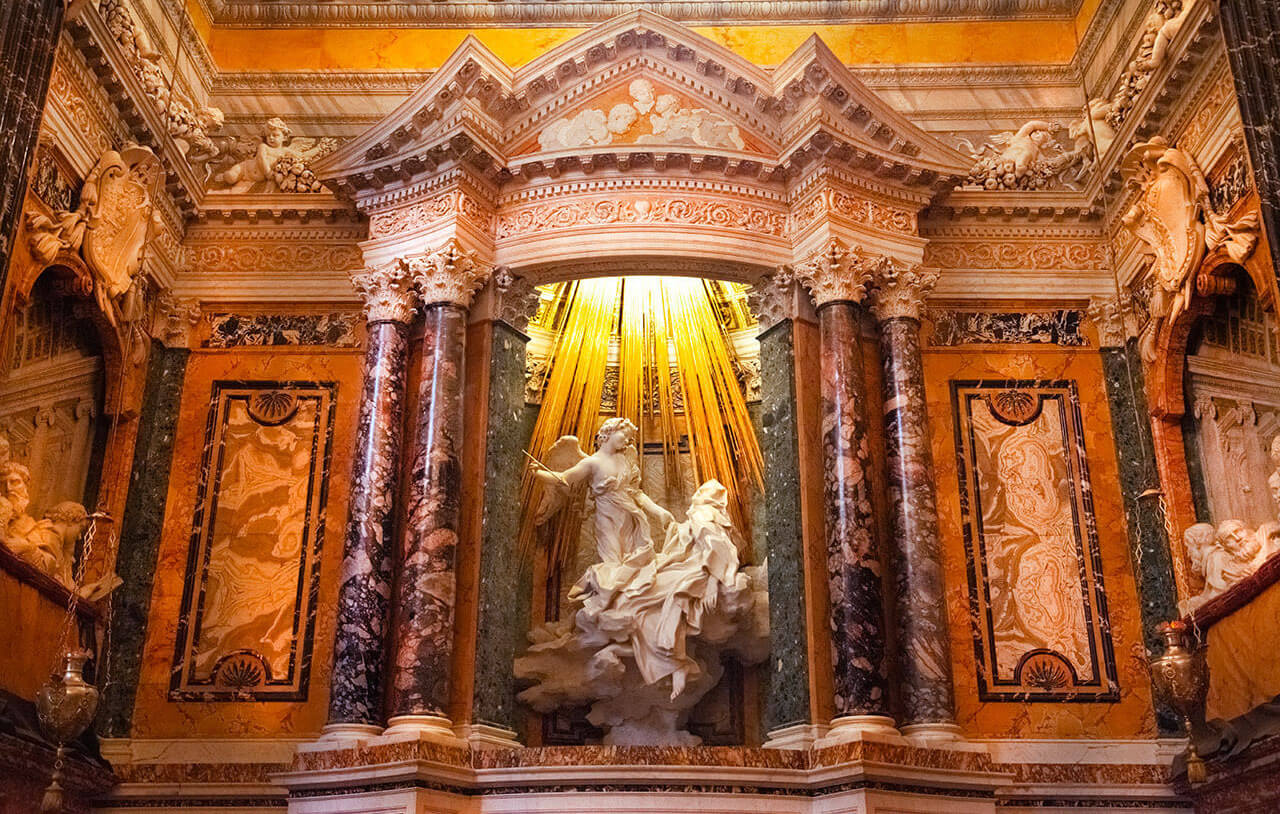
Famous Works of Art inside Santa Maria della Vittoria:
The pièce de résistance of this small church is undoubtedly the Cornaro Chapel, where Gian Lorenzo Bernini's masterpiece, the "Ecstasy of St. Teresa", captivates visitors with its passionate and controversial portrayal of the saint's divine encounter. The church's rich history and artistic treasures make it an unmissable gem among Rome's sacred wonders.
6. Church of San Luigi dei Francesi
San Luigi dei Francesi, situated near Piazza Navona, is the national church of France, dedicated to King Louis IX, the Virgin Mary, and Dionysius the Areopagite. Built between 1518 and 1589, the church's history traces back to the 10th century when refugees settled in Rome after an attack on the Abbey of Farfa. By 1480, it became Saint Louis of the French under the Medici family.
The construction, initiated by Jean de Chenevières in 1518, featured an octagonal design and was completed in 1589 by Domenico Fontana and Giacomo della Porta. The interior, restored in the 18th century, boasts frescoes by Charles-Joseph Natoire, depicting stories of Saint Louis IX, Saint-Denis, and Clovis. Managed by the foundation Pieux Etablissements de la France à Rome et à Lorette, the church is a testament to French art, history, and religious significance in Rome.
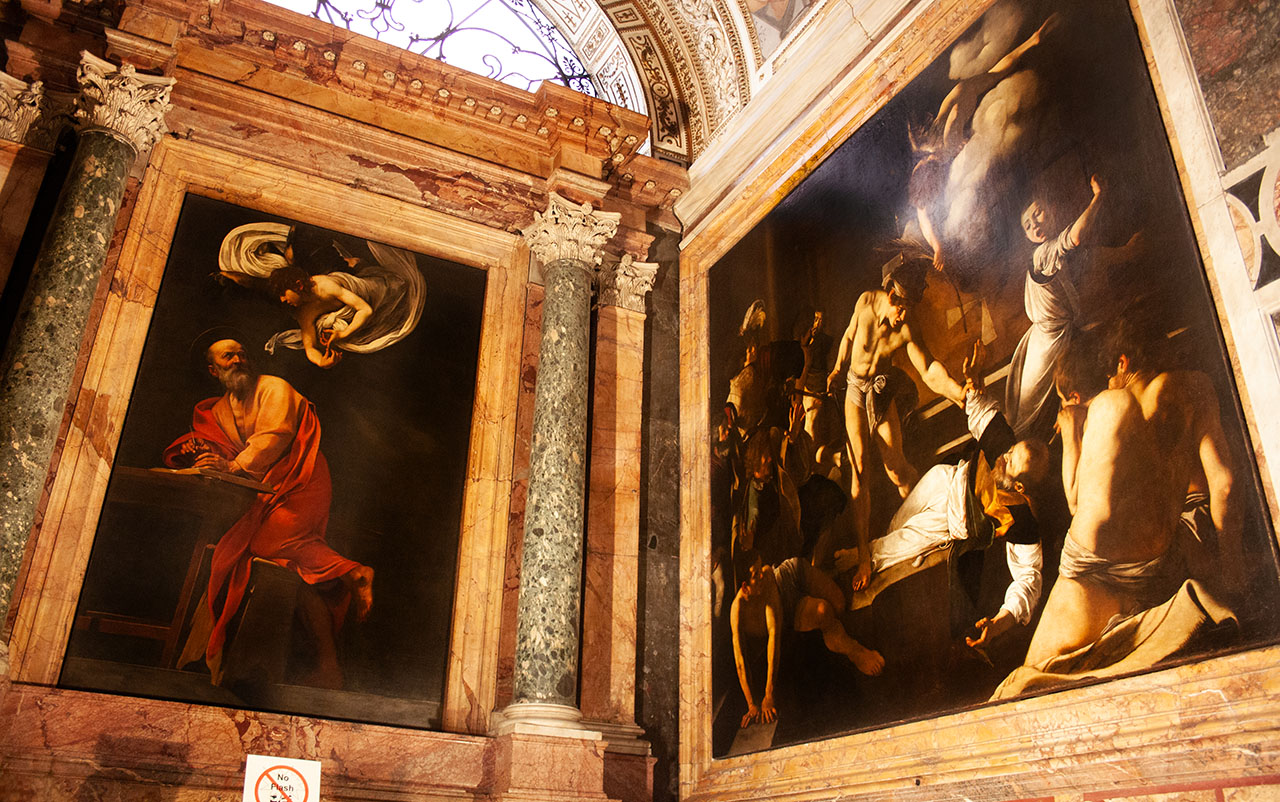
The Contarelli Chapel within San Luigi dei Francesi houses a cycle of paintings by Caravaggio, created in 1599–1600, depicting the life of St. Matthew. Masterpieces in the chapel include "The Calling of St Matthew", "The Inspiration of Saint Matthew", and "The Martyrdom of Saint Matthew". These works by Caravaggio contribute to the church's prominence in the art world.
7. Basilica of Sant'Agostino
The Basilica of Sant'Agostino, situated in the square bearing its name just near Piazza Navona, stands as an emblem of Renaissance architecture in Rome, with its origins tracing back to the 14th century. Commissioned by the Augustinians to replace their existing convent, the church underwent several renovations, culminating in its completion in 1420.
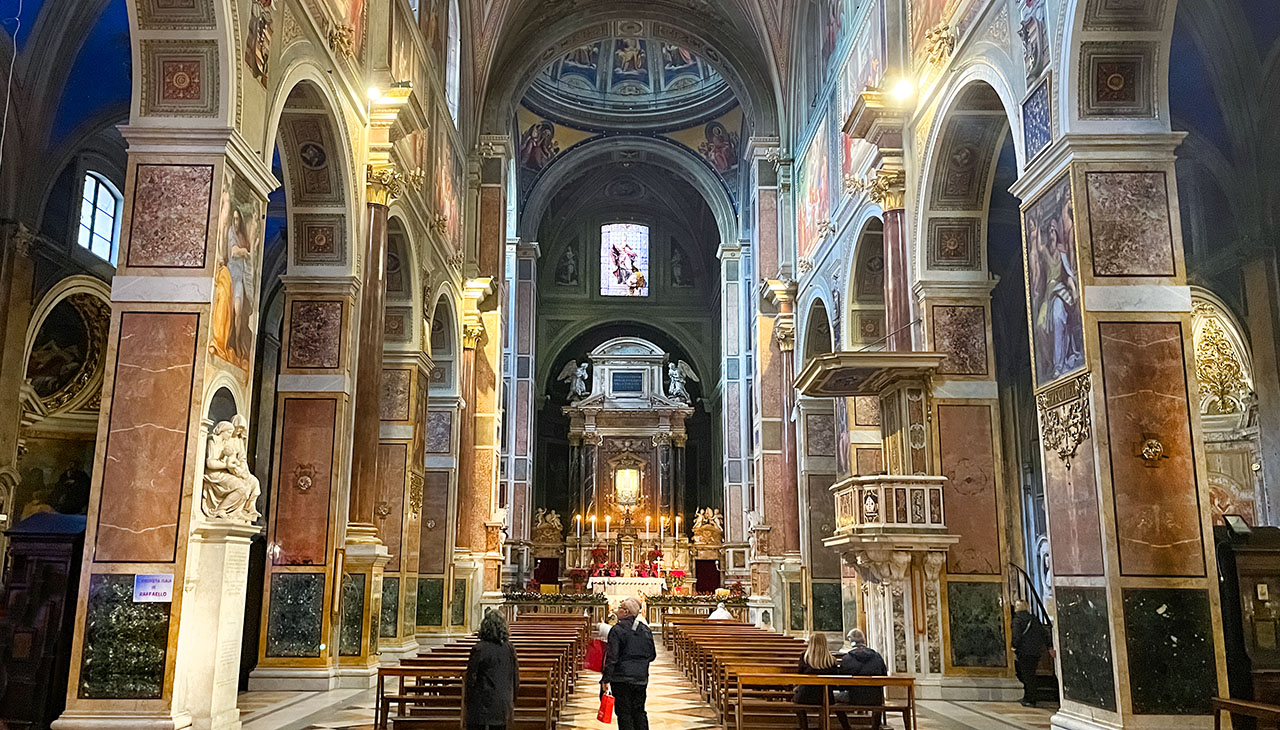
Over the years, the basilica saw transformations, including the Renaissance dome added in 1756 by Luigi Vanvitelli, making it the first of its kind in Rome. The façade, adorned with travertine blocks from the Colosseum, captivates visitors with its two-order design.
Inside this architectural gem, art and history converge seamlessly. Notable works include the "Madonna del Parto" by Jacopo Tatti, known as "il Sansovino", celebrated for its protection of women in childbirth. The central nave, with its pillars supporting round arches, features a mesmerizing fresco by Raphael and a captivating marble group by Andrea Sansovino.
However, the true artistic jewel lies in the first chapel on the left, where Caravaggio's masterpiece, the "Madonna of the Pilgrims" (1604), graces the walls. The basilica's interior also hosts illustrious tombs, adding layers of historical significance to this timeless sanctuary.
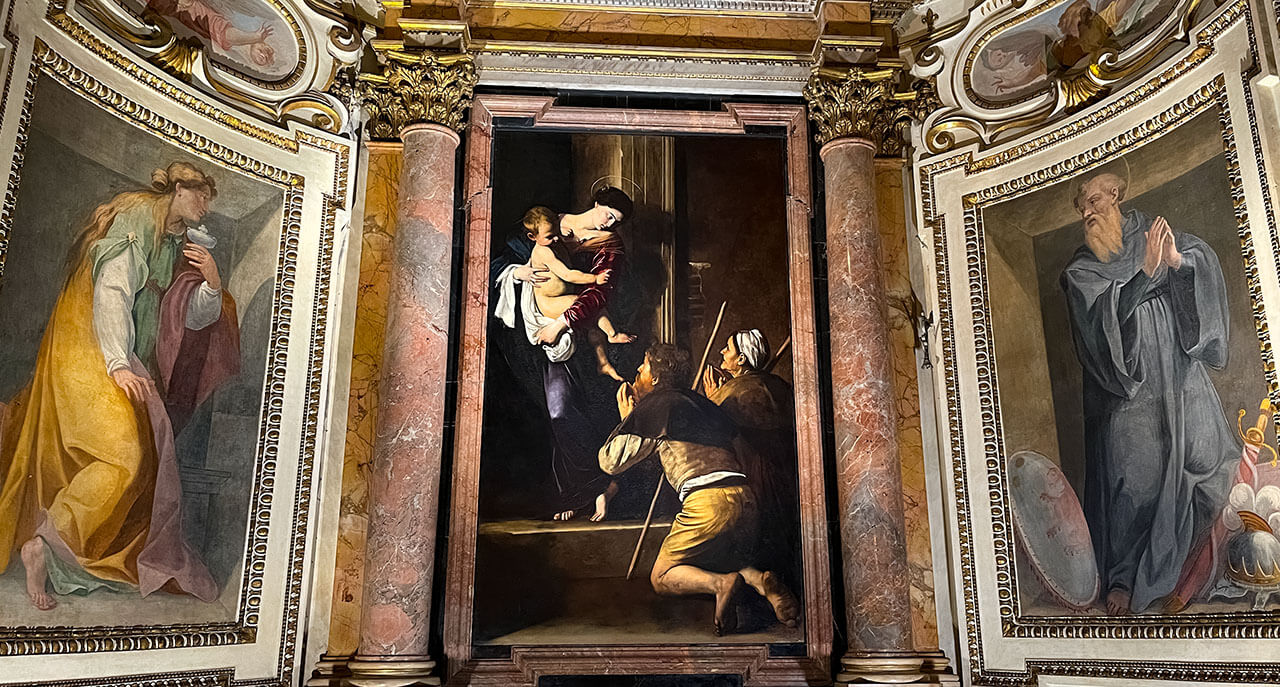
8. Santa Maria degli Angeli e dei Martiri
Santa Maria degli Angeli e dei Martiri, nestled within the ruins of the Baths of Diocletian overlooking Piazza della Repubblica, is a unique testament to the harmonious coexistence of ancient Roman architecture and Renaissance innovation.
Conceived at the behest of Pope Pius IV de' Medici in 1561, the venerable Michelangelo, even in his 86th year, undertook the task of creating a church within the expansive Baths. His design ingeniously integrated the sacred space into the existing Roman structure, preserving the rectangular hall over 90 meters long and incorporating the outdoor cold water pool (natatio) into the apse.
The façade, a remarkable concave brick structure, represents one of the ancient exedrae of the caldarium of the baths. Michelangelo's vision extended to the interior, where the basilica retained the ancient solemnity of the baths, adorned with red granite columns and lofty vaults.
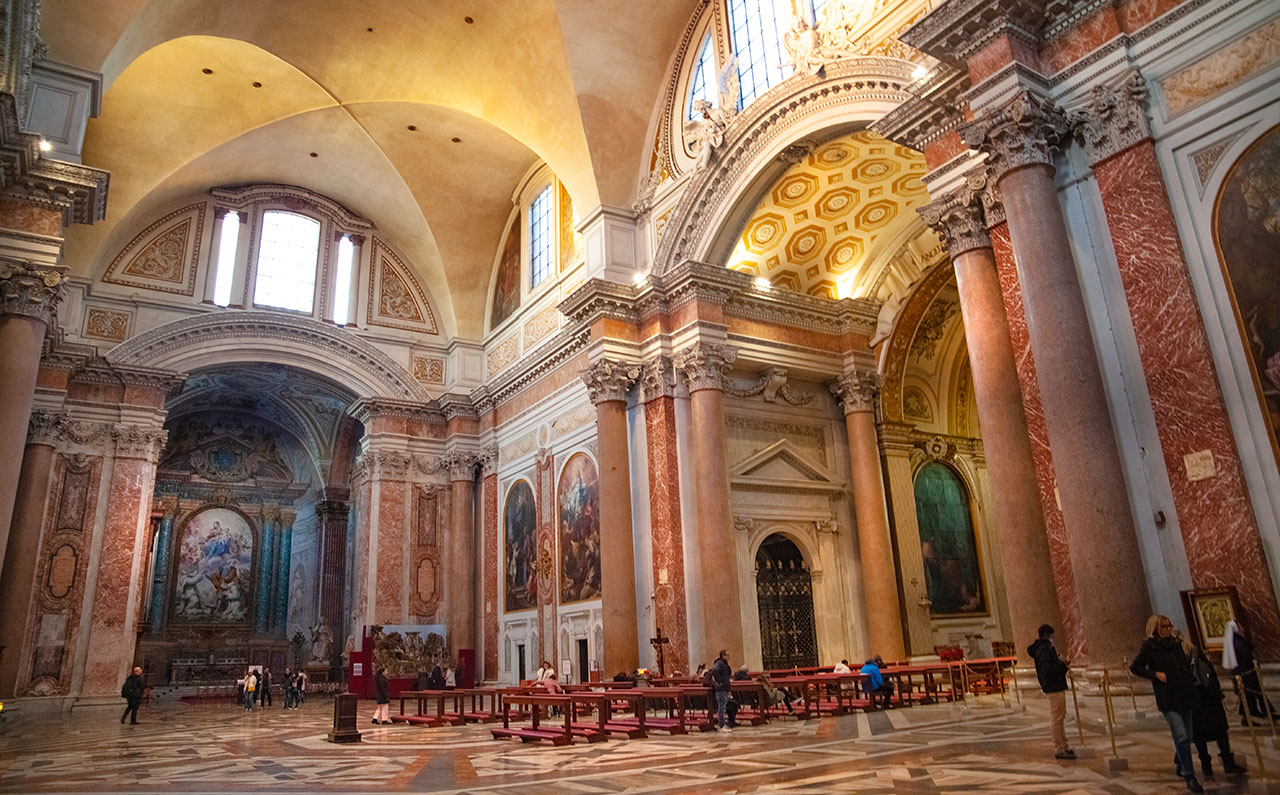
Noteworthy within is the Meridiana or Clementine Line, inaugurated in 1702, featuring a bronze sundial on a marble band that spans approximately 45 meters. The sundial, crafted by Francesco Bianchini, reflects the passage of time with zodiac signs and a central image of the sun, showcasing an astronomical spectacle throughout the year.
Over the centuries, the basilica underwent transformations, including alterations by Luigi Vanvitelli in 1750. The façade was demolished in 1911 to reveal the suggestive niche of the caldarium, constructed with Roman bricks. While this intervention rendered the church less visible, its historical significance and architectural beauty endure. This architectural masterpiece stands as a testament to the fusion of art, astronomy, and ancient marvels within the heart of Rome.
Speaking of Michelangelo, don't miss the next church that features another famous sculpture of Moses by the Maestro himself located in the church of Saint Peter in Chains (San Pietro in Vincoli).
9. San Pietro in Vincoli (Church of Saint Peter in Chains)
San Pietro in Vincoli, also known as Saint Peter in Chains, is a Roman Catholic titular church and minor basilica located on Oppian Hill near Cavour metro station, close to the Colosseum.
Originally named Basilica Eudoxiana, the church was reconstructed on ancient foundations between 432 and 440 to enshrine the relic of the chains believed to have bound St. Peter during his imprisonment in Jerusalem, an event known as the "Liberation of Saint Peter".
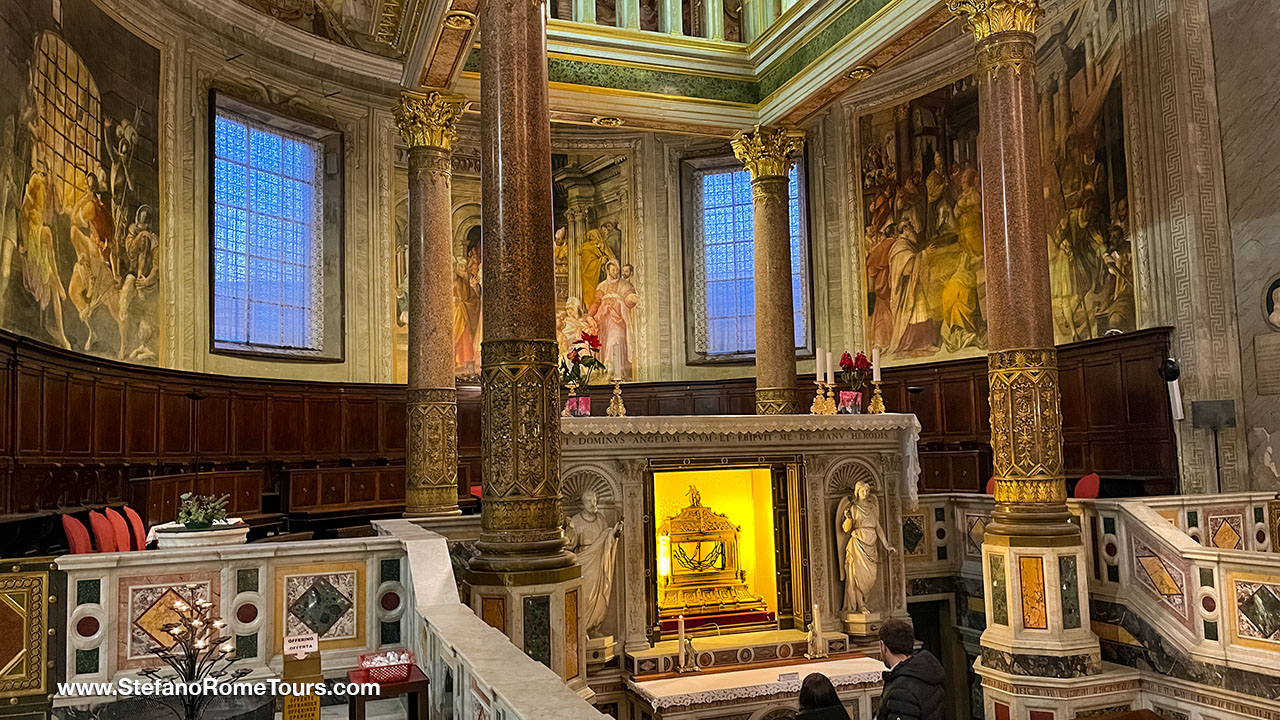
Empress Eudoxia presented these chains to Pope Leo I, and legend has it that when Leo compared them to the chains from St. Peter's final imprisonment in Rome's Mamertine Prison, the two chains miraculously fused together. Today, these chains are preserved in a reliquary beneath the main altar.
The most famous work of art inside this church is Michelangelo's Moses, completed in 1515. Originally part of a grand funeral monument for Pope Julius II, it became the centerpiece of the Pope's tomb in San Pietro in Vincoli.
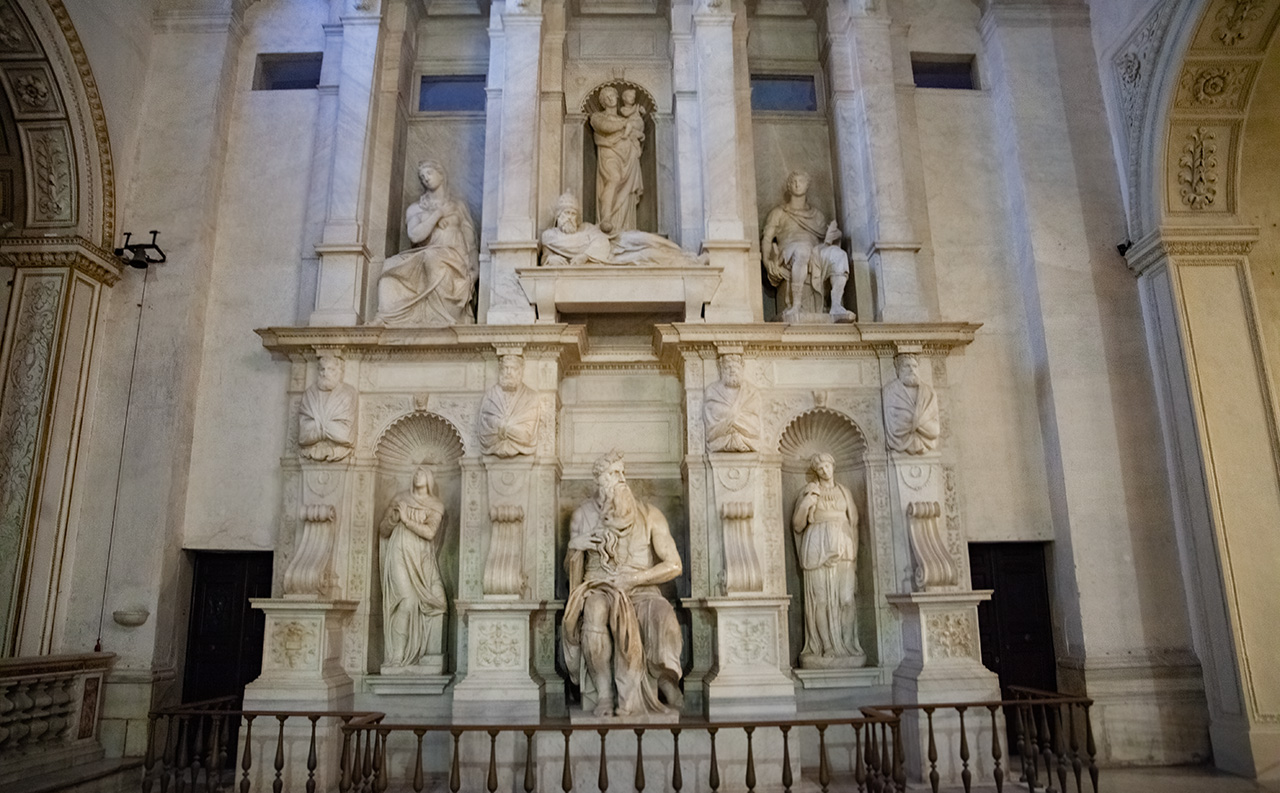
10. Church of Santa Maria in Trastevere
Santa Maria in Trastevere is one of Rome's oldest churches located in Piazza Santa Maria in Trastevere. Dating back to the 4th century. Originally built by Pope Callixtus I, it underwent renovations in the 5th and 8th centuries, with significant reconstruction under Pope Innocent II in 1140-43. The church features a Romanesque campanile from the 12th century and an interior with 22 granite columns from the Baths of Caracalla.
The façade, restored by Carlo Fontana in 1702, boasts a niche with a 12th-century mosaic of the Madonna and Child by Pietro Cavallini. The church's interior maintains its original basilica plan, and Domenichino's "Assumption of the Virgin" adorns the coffered ceiling.
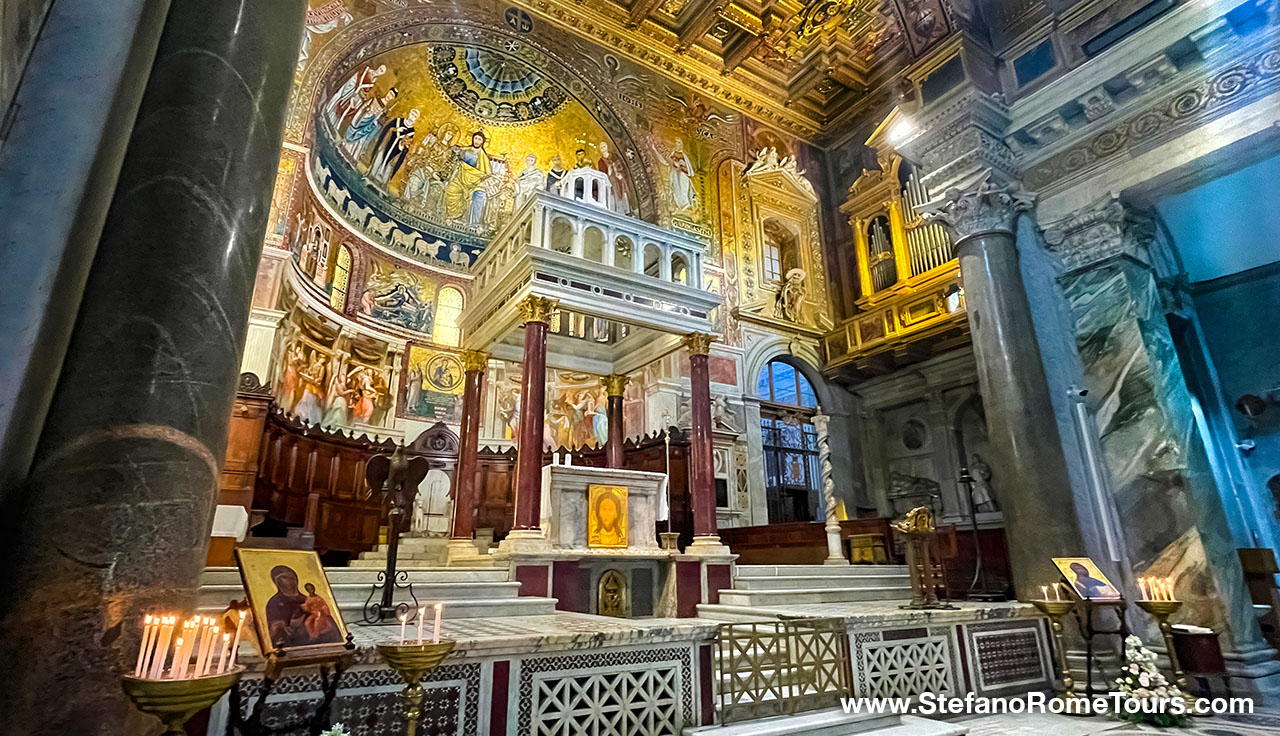
The church also houses relics of Saint Apollonia and Pope Callixtus I. Designated as a Titular church since at least the 3rd century, it holds historical significance.
Noteworthy mosaics include the "Coronation of the Virgin" and Pietro Cavallini's "Life of the Virgin". The Avila Chapel, designed by Antonio Gherardi, is architecturally inventive.
- Visit the Church of Santa Maria in Trastevere on these private Rome Tours and Civitavecchia Shore Excursions: La Dolce Vita Rome Tour, La Dolce Vita Rome Private Excursion from Civitavecchia, and La Dolce Vita Rome Post Cruise Tour from Civitavecchia.
11. Basilica of Santi Giovanni e Paolo al Celio
Perched atop the Caelian hill, the Basilica of Santi Giovanni e Paolo al Celio is steeped in history and legend. The basilica derives its name from two Roman soldiers who, according to legend, were persecuted by Emperor Julian the Apostate and buried in their own house.
This site transformed into a pilgrimage destination, prompting the construction of a "titulus" in honor of the martyred brothers by Senator Byzantis and his son Pammachius in the 5th century.
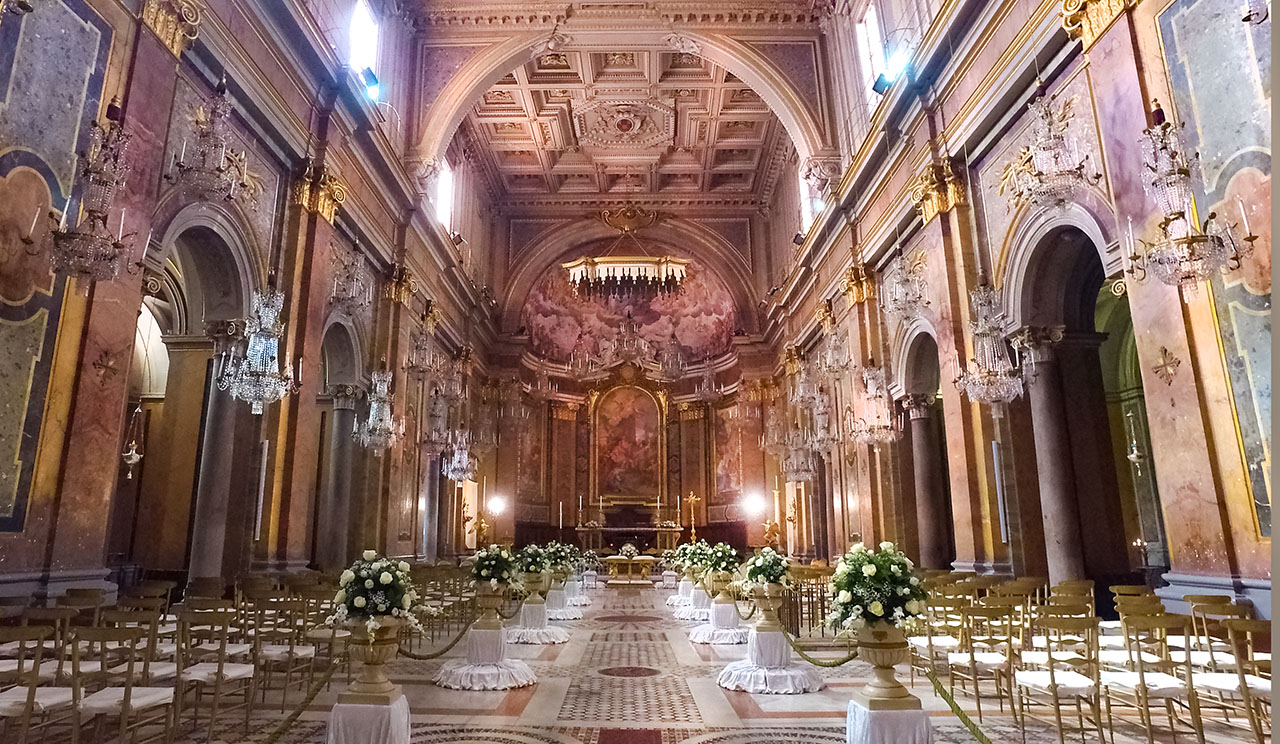
The church, subject to destruction and reconstruction over the years, underwent significant rebuilding in the 12th century, featuring a captivating portico and a towering bell tower situated atop the remnants of the Temple of Emperor Claudius. Cardinal Cencio Savelli's modifications in 1216 added an upper gallery and a striking Cosmatesque portal adorned with an eagle and flanked by lions.
Case Romane del Celio
Beneath the Basilica, accessible from Via del Clivo di Scauro, lies the remarkable archaeological complex known as the "Case Romane nel Celio / Roman Houses on Celian Hill".
Discovered in 1887 by Father Germano of San Stanislao, these underground wonders comprise twenty well-preserved rooms, offering a captivating journey through Roman residential life from the 1st to the 4th century.
Originally part of an insula, the rooms served various purposes over the centuries, from a two-level domus with a private thermal plant to a complex with shops and houses. Tradition holds that this site was where Saints John and Paul lived, suffered martyrdom, and were buried, leading to the sacred status and subsequent construction of the basilica above.
This underground marvel encapsulates centuries of history, providing a unique glimpse into the coexistence of paganism and Christianity in ancient Rome. For more churches with underground ruins dating as far back as Ancient, Rome, check out the Basilica of San Clemente.
12. Basilica of San Clemente
Located in Piazza di S. Clemente along Via di San Giovanni in Laterano a few blocks behind the Colosseum, the Basilica of San Clemente is a captivating testament to Rome's layered history, featuring three distinct levels of construction spanning various centuries. Similar to the Basilica of Santi Giovanni e Paolo, this basilica too sits on top of ancient Roman sites waiting for your discovery.
The present basilica, built around 1100 AD, is just the surface of this intricate archaeological site. Below it lies a 4th-century basilica, converted from a Roman nobleman's home, which had briefly served as an early Christian church in the 1st century. Even further down, beneath the 4th-century structure, are remnants of a Roman house and a pagan temple dating back to the 1st century AD.

Transformed over the centuries, the ancient church reflects the evolution of clandestine Christian worship in the 1st century to a grand public basilica by the 6th century. Joseph Mullooly, the Prior of the Irish Dominicans at San Clemente in the 19th century, discovered the archaeological traces of the basilica's history in the 1860s.
The lower levels reveal remnants of a possibly Republican-era building, potentially destroyed in the Great Fire of 64. An industrial building, likely the imperial mint from the late 1st century AD, was constructed or modified on the same site. Subsequent layers include an insula (an Ancient Roman apartment block) and a Mithraeum, a sanctuary for the cult of Mithras, dating to around 200.
The first basilica, known to exist in 392, was the site of important councils and underwent restorations in the 9th century and around 1080–99. Frescoes sponsored by Beno de Rapiza and Maria Macellaria in the 11th century depict scenes from the lives of St. Clement and St. Alexius.
The current basilica, rebuilt in the late 11th century by Cardinal Anastasius, boasts a richly adorned interior with Cosmatesque inlaid paving, a 12th-century schola cantorum, and a ciborium raised over the shrine of St. Clement. The presbytery features exquisite mosaics depicting the Triumph of the Cross. The Basilica of San Clemente has been under the ownership of Irish Dominicans since 1667, who conducted excavations in the 1950s.
13. Basilica of Santa Maria Maggiore
The Basilica of Saint Mary Major, also known as Santa Maria Maggiore in Italian, stands as a monumental testament to the veneration of the Virgin Mary and holds a significant place in both Roman Catholic history and architecture. It is one of the Seven Pilgrim Churches of Rome and the largest Catholic Marian church in the city.
Dating back to the 5th century, the basilica's establishment is linked to the Council of Ephesus in 431, where the title "Theotokos" (Mother of God) was officially given to the Virgin Mary. Pope Sixtus III built Santa Maria Maggiore to commemorate this pivotal decision, making it one of the first churches built to celebrate the Virgin Mary.
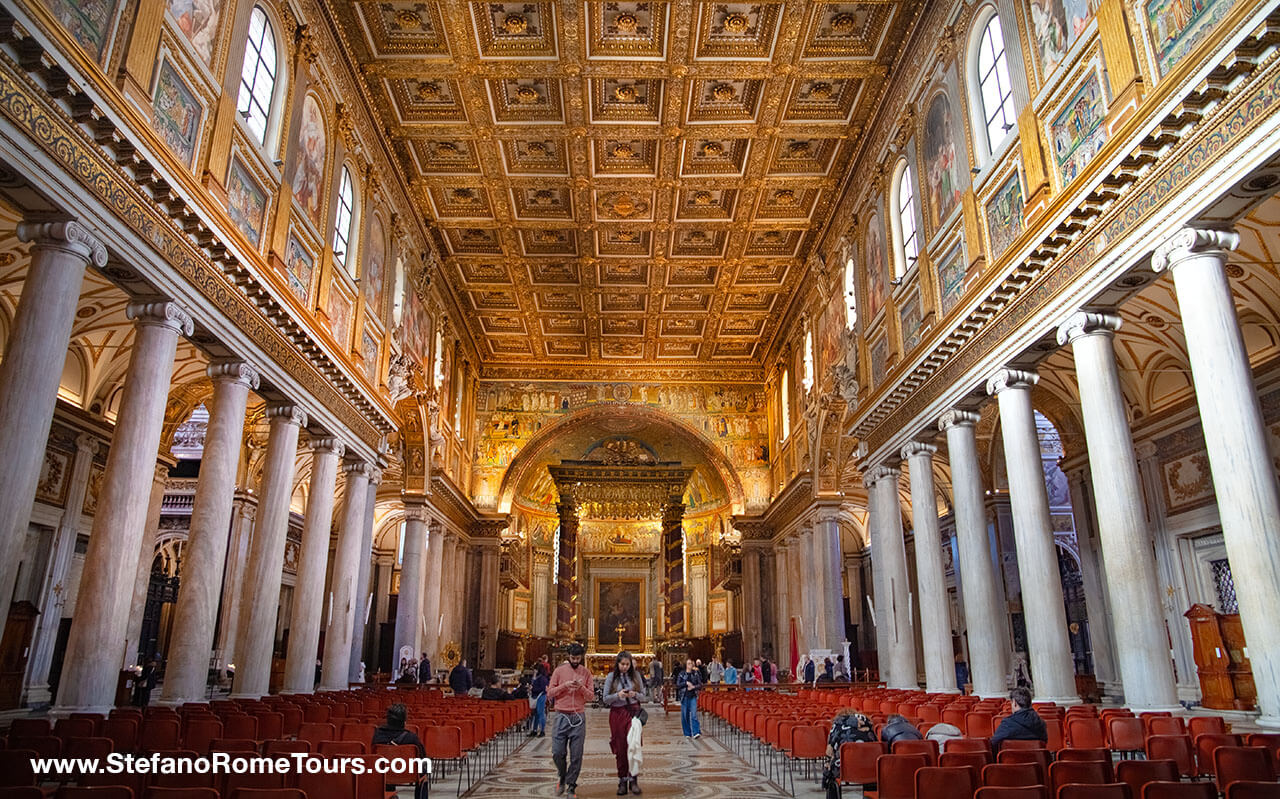
The legend of a miraculous snowfall on Esquiline Hill in August influenced the dedication, and the church is often referred to as Our Lady of the Snows.
The Basilica holds immense religious significance as it enshrines the venerated image of Salus Populi Romani, depicting the Blessed Virgin Mary as the health and protectress of the Roman people. Pope Gregory XVI granted the image a Canonical coronation in 1838, underscoring its importance in Roman Catholic devotion.
Gian Lorenzo Bernini is interred in the Basilica di Santa Maria Maggiore in Rome. The tomb of the Bernini Family, including Gian Lorenzo Bernini, is situated in the right lateral nave of the basilica. The tomb features a simple inscription in Latin that expresses hope for the resurrection of Peter and Gian Lorenzo. Notably, the workshops of Gian Lorenzo Bernini were located directly behind the Pauline Chapel, adding a historical and contextual significance to the placement of the tomb within the basilica. Visiting this tomb allows admirers of Bernini's work to pay their respects to the artist and his family.
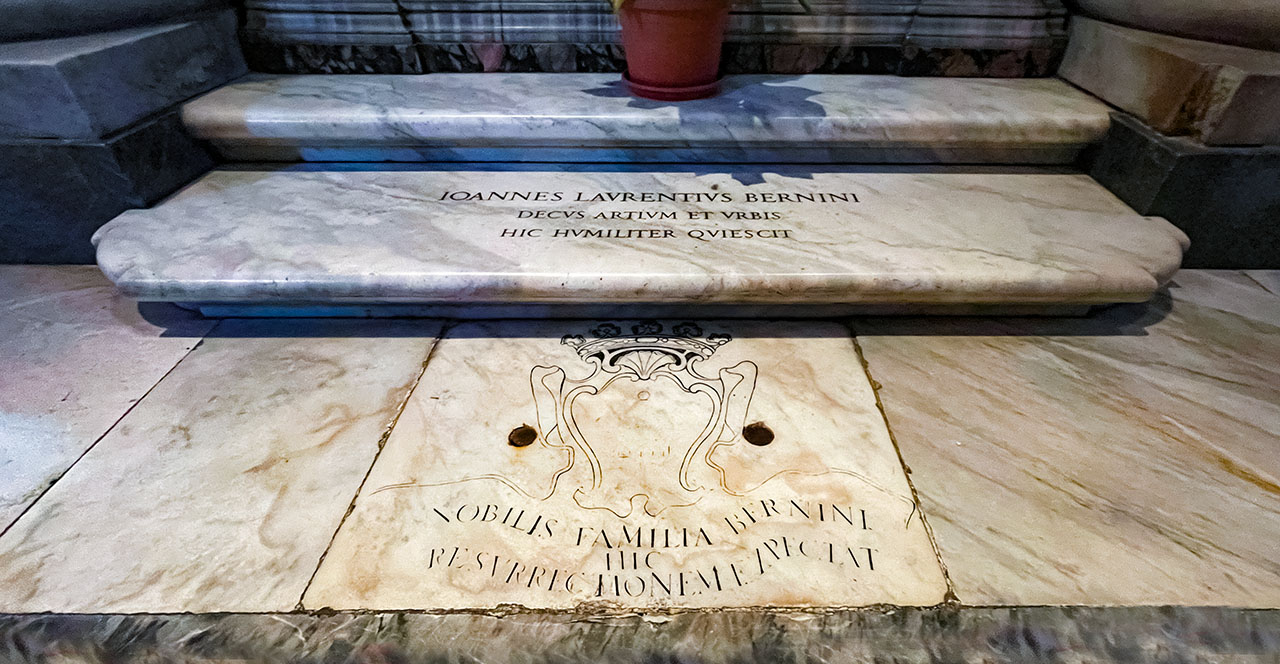
Must-See Works of Art in the Basilica of Santa Maria Maggiore
Mosaics
The basilica is adorned with a stunning collection of mosaics, some dating back to the 5th century. These mosaics depict various scenes from the life of the Virgin Mary, events from the Old Testament, and the life of Christ. The mosaics serve as a visual narrative, illustrating the rich history of Christianity.
The Triumphal Arch
The triumphal arch within the basilica is embellished with magnificent mosaics illustrating different scenes of Christ and the Virgin Mary. The style of these mosaics is characterized by late antique impressionism, reflecting influences from frescoes, manuscript paintings, and pavement mosaics of the 5th century.
Oratory of the Nativity
The Oratory or Chapel of the Nativity, located in the Crypt of the Nativity, holds historical importance as it is where Ignatius of Loyola celebrated his first Mass as a priest on December 25, 1538. The basilica's connection to significant events in Christian history is further emphasized through such sacred spaces.
Crypt of the Nativity
Under the high altar, the Crypt of the Nativity contains a crystal reliquary designed by Giuseppe Valadier, believed to house wood from the Holy Crib of the Nativity of Jesus Christ. This sacred space adds to the reverence and historical significance of the basilica.
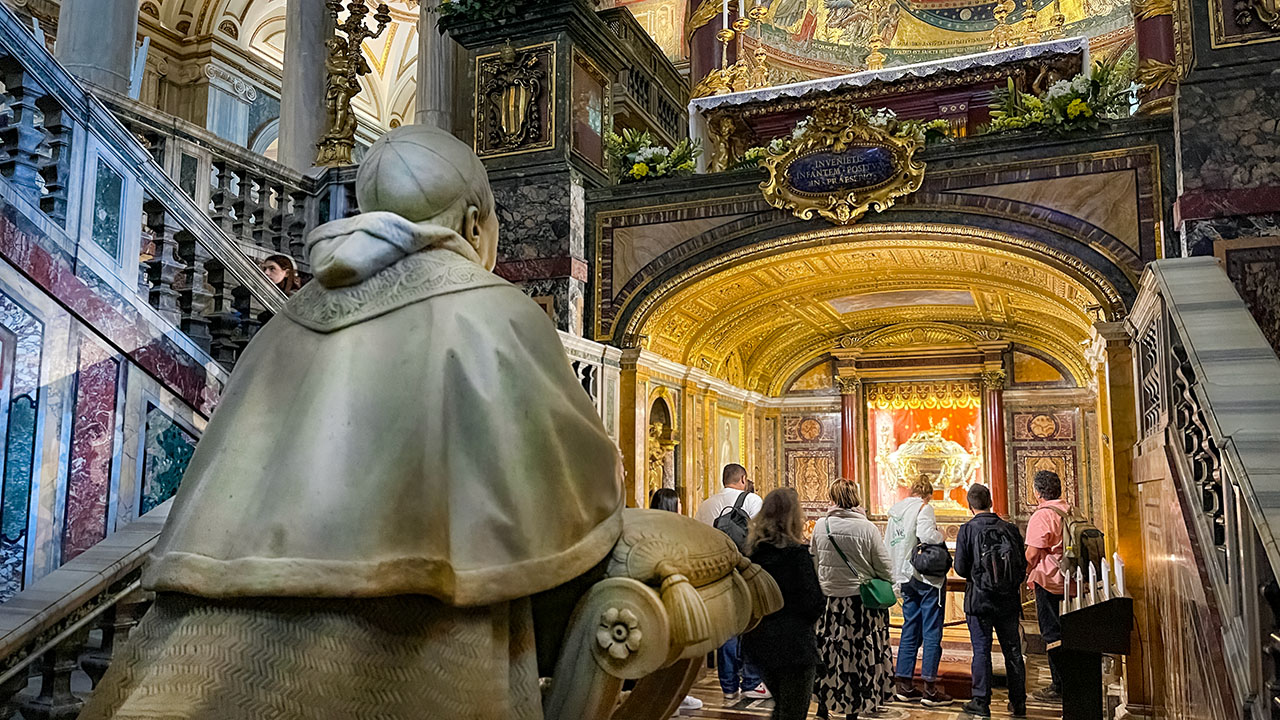
14. Basilica of St. John Lateran
Basilica of St. John Lateran (in Italian: Basilica di San Giovanni in Laterano), founded in 324, is the oldest public church in the city. It serves as the cathedral of the Bishop of Rome (the Pope) and is titled the ecumenical mother church of the Catholic Church. Originally dedicated to Christ the Savior, it underwent rededication centuries later to honor Saints John the Baptist and John the Evangelist.
Noteworthy reconstructions occurred in the late 16th century under Pope Sixtus V and in the late 17th century, shaping the present interior. The neo-classical façade, completed in 1735 by Alessandro Galilei under Pope Clement XII, marks its exterior. The Lateran Obelisk in front, commissioned by Thutmose III, is a testament to ancient Egyptian influence in Rome.
Architect Francesco Borromini's 17th-century vision revitalized the interior, showcasing a remarkable apse with mosaics preserving the memory of Pope Leo III's "Triclinium," an ancient state banqueting hall.
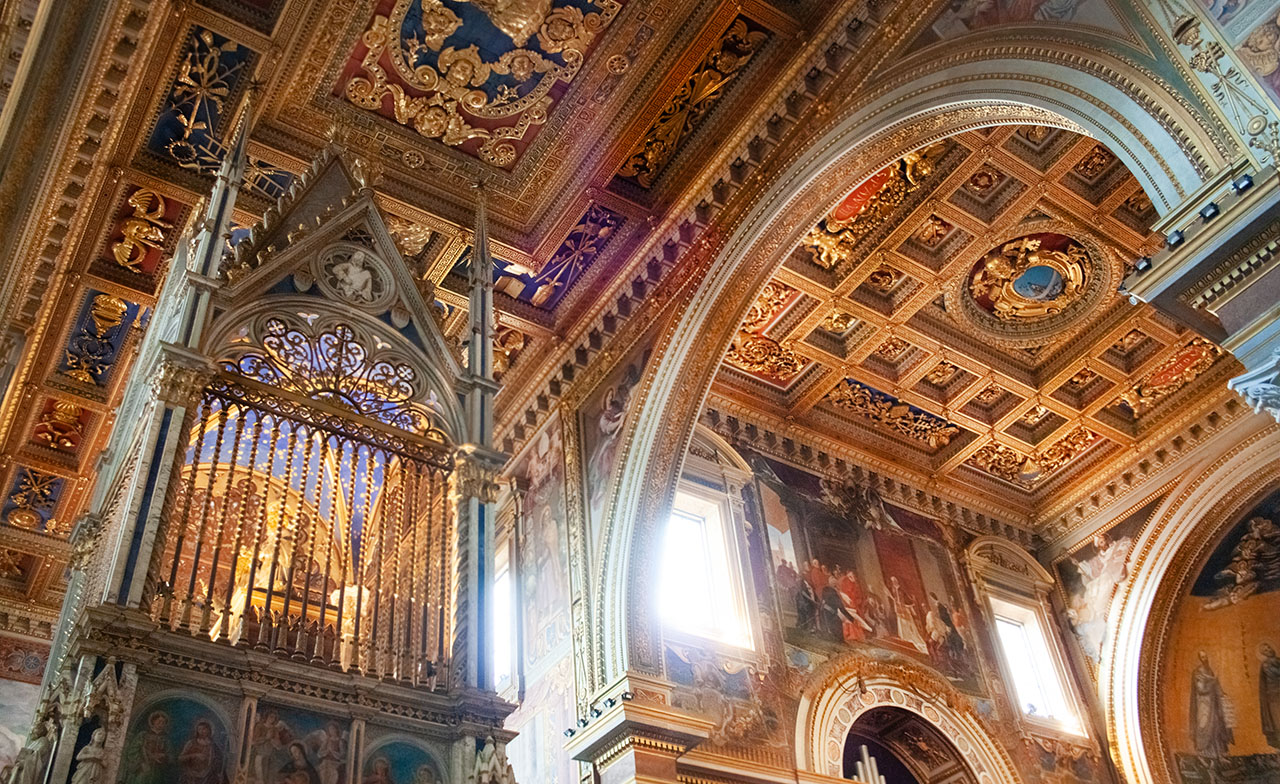
Despite facing fires in 1307 and 1361, the basilica underwent reconstruction, with Pope Sixtus V's program seeing the replacement of the Lateran Palace. The basilica's role in housing the Bishop of Rome until Pope Clement V and hosting five ecumenical councils underscores its historical significance.
Today, the Basilica of St. John Lateran stands as a testament to the enduring influence of the Catholic Church, inviting visitors to explore its rich history and architectural grandeur
Interior Notable Features: the 12 Apostles
In 1702, Pope Clement XI and Cardinal Pamphili initiated a project to fill the twelve vacant niches in Francesco Borromini's architecture at the Basilica of St. John Lateran. The plan involved commissioning twelve larger-than-life sculptures of the Apostles, with Saint Paul replacing Judas Iscariot.
Illustrious princes sponsored each statue, including Pope Clement for Saint Peter and Cardinal Pamphili for Saint John the Evangelist. Sculptors adhered to sketches by Carlo Maratta, except for Pierre Le Gros the Younger, who declined to follow Maratta's design. This collection reflects the artistic collaboration and patronage of the Baroque era.
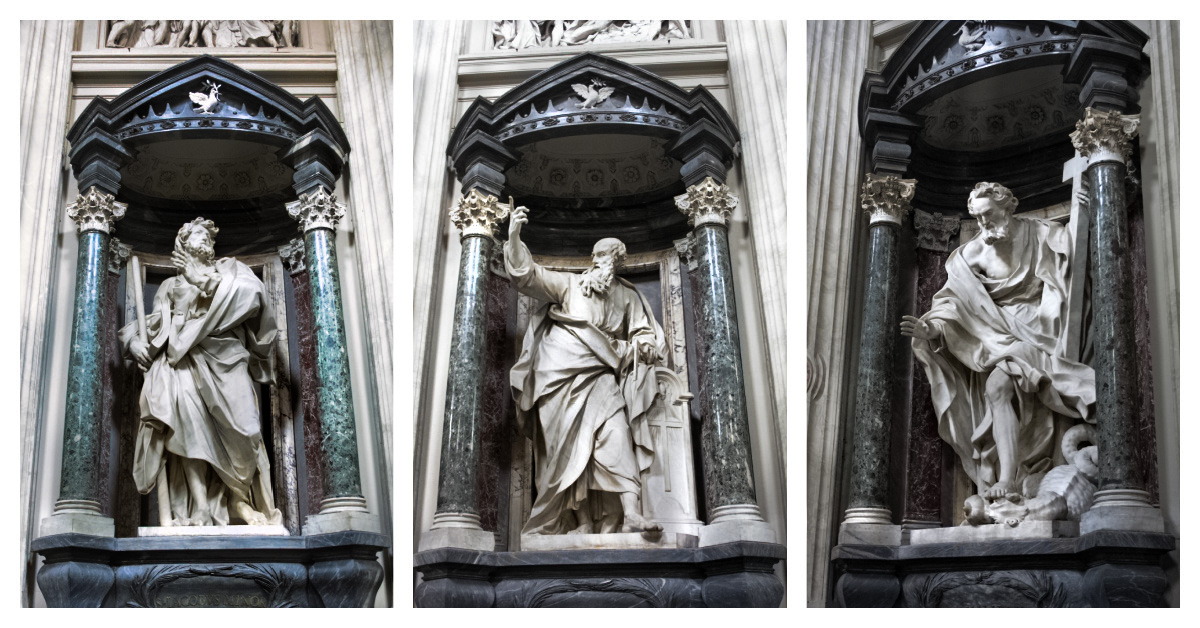
15. Church of Santa Maria sopra Minerva
The Church of Santa Maria Sopra Minerva is a significant site in Rome almost hidden behind the Pantheon, unnoticed by most visitors who flock to the famous Ancient Roman monument. However, head over behind the Pantheon and you will discover a hidden treasure behind the plain facade of this remarkable church.
Showcasing original Gothic architecture, this church is the only extant example of such in the city. The church has a rich history, having served as the Dominican Order's headquarters. The site has Roman roots, with temples to Minerva, Isis, and Serapis in the vicinity.
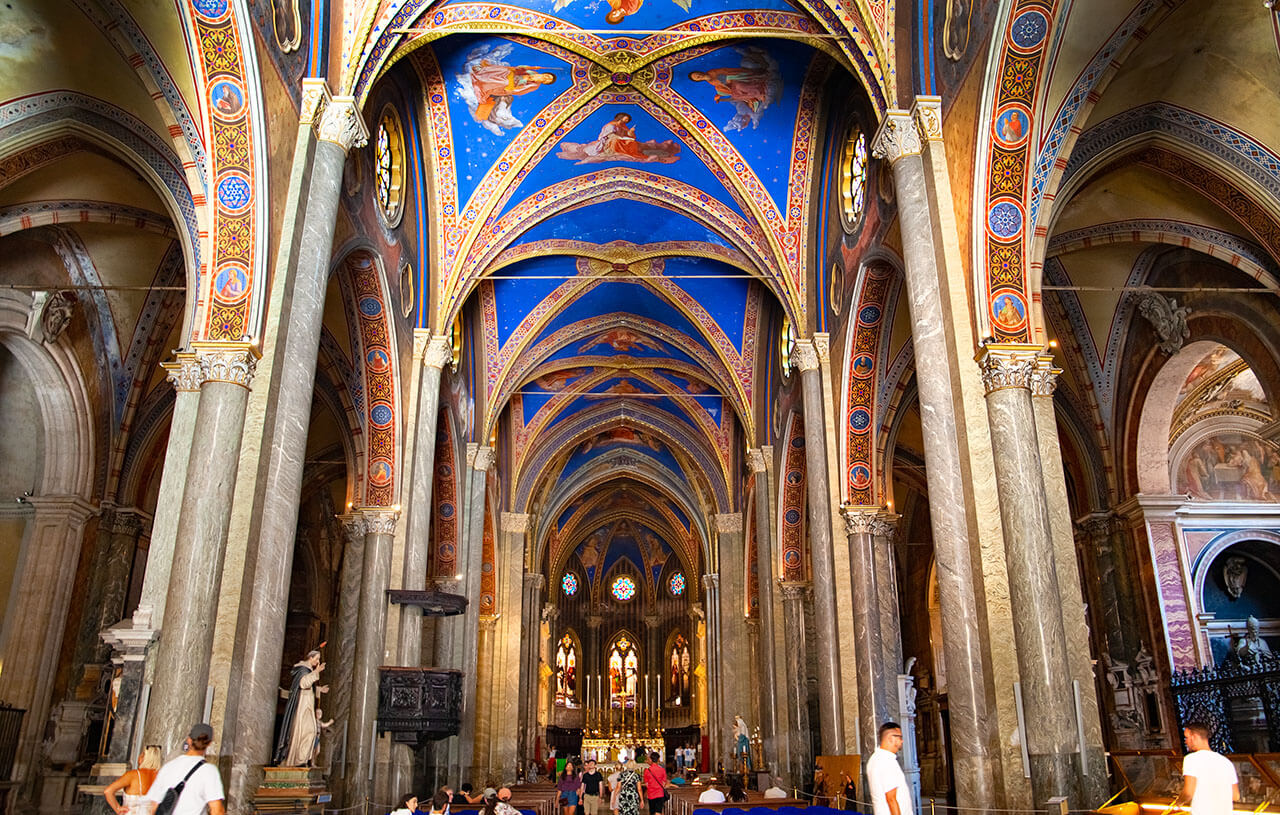
In the 13th century, Pope Alexander IV established a Dominican convent, leading to the construction of the present church. The façade was completed in 1725 under Pope Benedict XIII. Throughout its history, Santa Maria sopra Minerva has been a witness to significant events, including Papal conclaves in 1431 and 1447. It has been a titular church since 1557 and a minor basilica since 1566.
Santa Maria Spora Minerva features a restrained Renaissance façade, concealing a Neo-Gothic interior with blue-vaulted ceilings adorned with gilded stars and red ribbing, restored in the 19th century.
The church's stained glass windows date mostly from the 19th century and its great organ was constructed in 1909. The basilica has a collection of inscriptions, and the Dominican Order has a long association with the site.
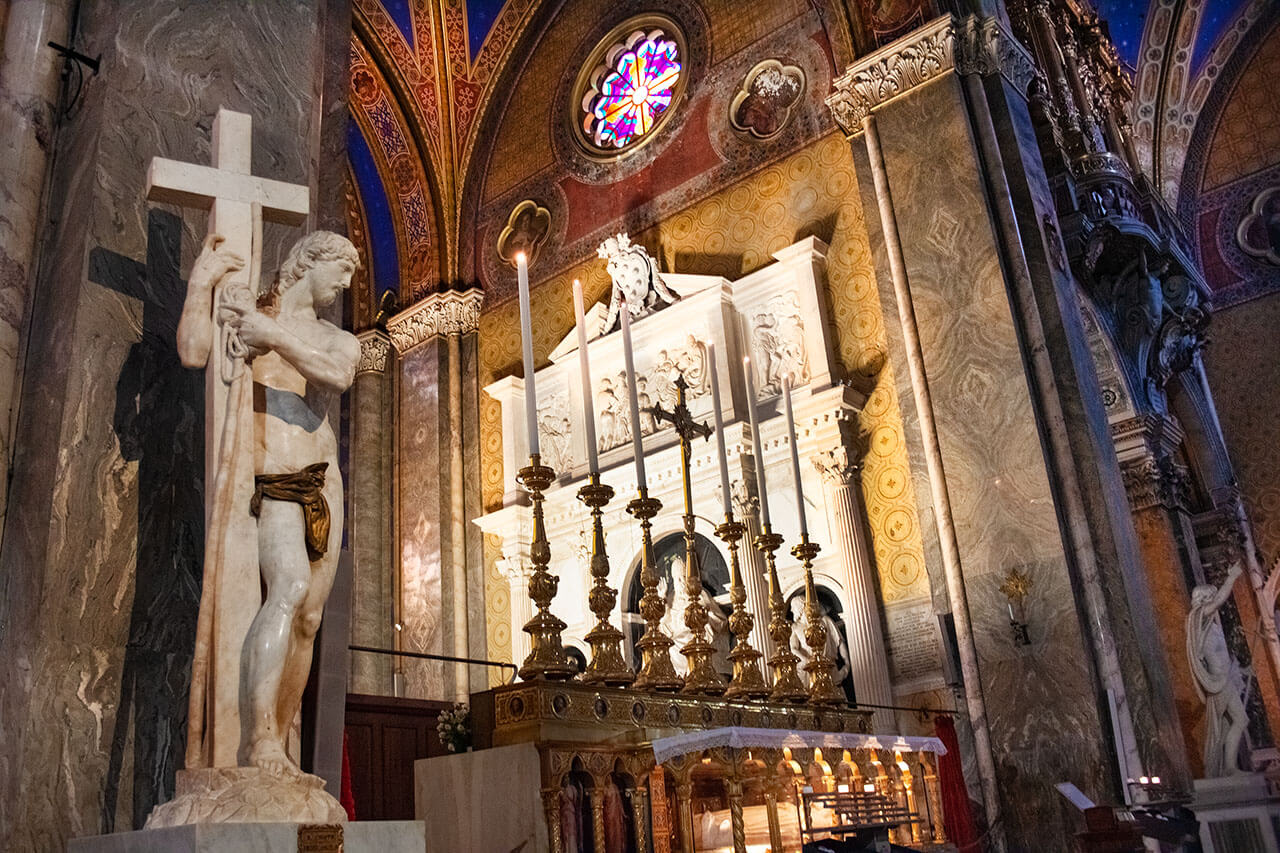
What to See inside Santa Maria Sopra Minerva
The Church of Santa Maria sopra Minerva in Rome houses several notable works of art. One of the most famous is Michelangelo's sculpture of Christ, known as the "Christ the Redeemer". This masterpiece by Michelangelo is a significant attraction within the church. Unfortunately, specific details about this sculpture are not widely available due to limited information.
The Gothic interior, restored in the 19th century, showcases arched vaulting painted blue with gilded stars and red ribbing. The church has stained glass windows mostly from the 19th century, contributing to its visual splendor.
The obelisk in the square of the Minerva in Rome, also known as the Pulcino della Minerva, is part of a monumental complex that includes an Egyptian obelisk dating from the 4th century BC. Positioned on the back of a marble elephant sculpted by Ercole Ferrata based on a design by Bernini in 1667, the obelisk and elephant together create a unique and iconic structure.
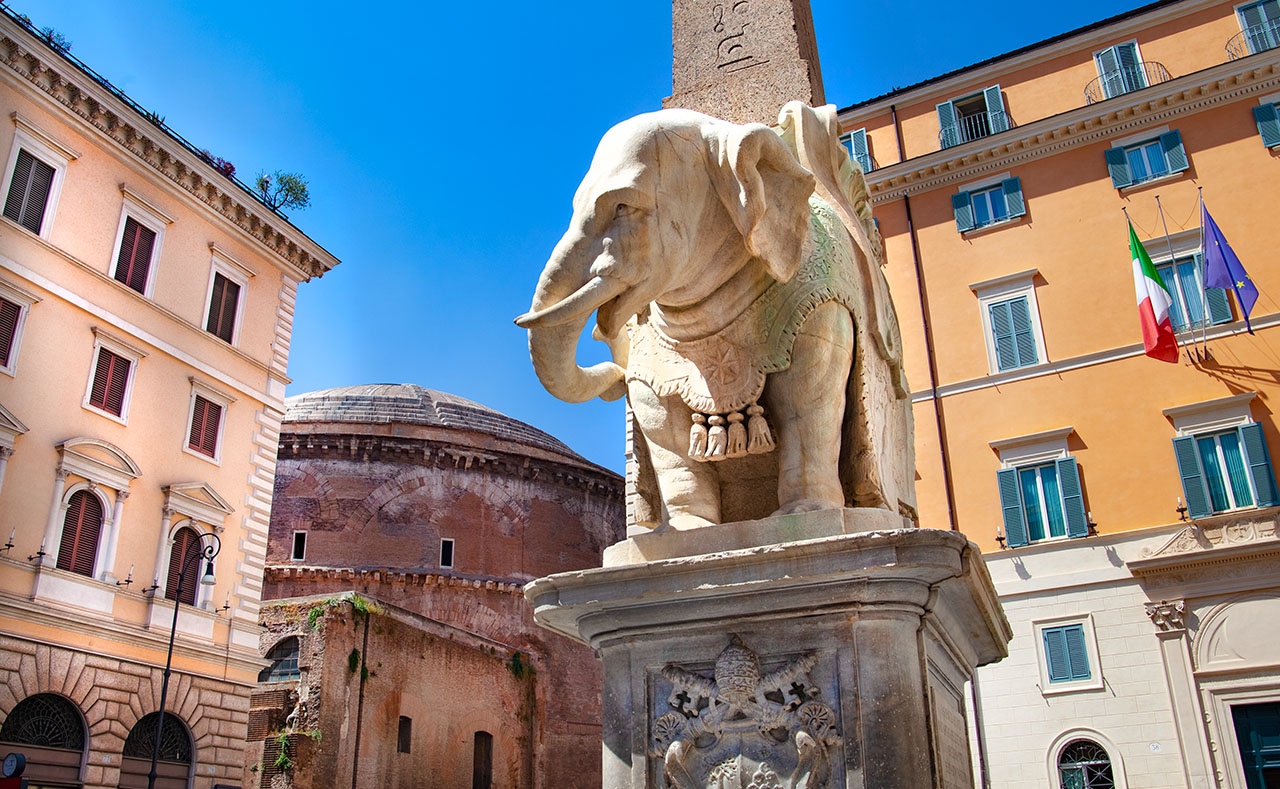
The elephant is often referred to as "pulcino" in the dialect of the time, meaning "porcino", highlighting its small size and round shapes. The obelisk, originally from Heliopolis, stands approximately 5.50 meters tall, with its summit reaching a ground height of 12.70 meters. It was transported to Rome during the reign of Domitian and placed in the Temple of Isis at Campo Marzio. The arrangement of the obelisk on the elephant was conceived by Gian Lorenzo Bernini.
The inscription on the base of the monument emphasizes the symbolism of the elephant carrying the obelisk, representing the strength of the mind required to sustain solid wisdom. The inscription reads:
SAPIENTIS AEGYPTI
INSCULPTAS OBELISCO FIGURAS
AB ELEPHANTO
BELLUARUM FORTISSIMA
GESTARI QUISQUIS HIC VIDES
DOCUMENTUM INTELLIGE
ROBUSTAE MENTIS ESSE
SOLIDAM SAPIENTIAM SUSTINING
(Translation)
“Whoever here see the signs of the Wisdom of Egypt engraved on the obelisk, supported by the elephant, the strongest of the beasts, understands this as proof that a robust mind is necessary to sustain a solid wisdom”.
The model for the elephant was offered as a gift to the City by Christina of Sweden, who had converted to Catholicism. The elephant's iconography is borrowed from the Hypnerotomachia Poliphili. The elephant is considered a symbol glorifying Pope Alexander VII, as expressed in contemporary poetry that associates the obelisk, symbolizing the sun, with the wisdom of the elephant and the gifts of the sun bestowed upon Alexander VII.
In concluding our journey through the sacred splendor of Rome's top must-visit churches, it becomes evident that the Eternal City stands as a treasure trove of spiritual and artistic marvels. Each church tells a unique tale, weaving together history, art, and devotion.
From the grandeur of Michelangelo's masterpiece sculptures in St. Peter's Basilica, Saint Peter in Chains, and Santa Maria Sopra Minerva, Rome's churches reflect the city's rich cultural heritage. Whether you are drawn to the timeless beauty of Michelangelo's Pieta or the mesmerizing chiaroscuro of Caravaggio in San Luigi dei Francesi and Sant'Agostino, these sacred spaces offer a profound connection to the divine and the artistic.
As you explore these spiritual sanctuaries, may you discover the profound beauty and enduring sacred splendor that defines Rome's churches, leaving an indelible mark on the hearts of all who visit.
Thank you for reading our travel blog top 12 must-visit chuches in Rome, and for choosing Stefano Rome Tours for your private tours in Italy and Civitavecchia Shore Excursions. We look forward to showing you amazing places in Italy!
